|
|
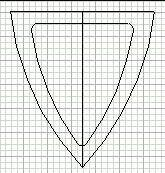 To get a little more speed, and endurance, or range, I faired in the rear of the fuselage. The rear of the fuselage cage tapers from six inches at the top to 5.5 inches at the bottom. The profile wall thickness was made .25 inches thicker next to the fuselage to accommodate the reduction in width. The idea was to glue profile foam pieces together to form the fairing and then sand away the extra width. The previously described template and wall papering technique was used. The fairing needs to cover about 25 inches of fuselage and another 2.5 inches down over the top and sides of the tail boom. Front to back fairing length was determined by the distance from the back of the fuselage to the back of the aileron torque tubes.
To get a little more speed, and endurance, or range, I faired in the rear of the fuselage. The rear of the fuselage cage tapers from six inches at the top to 5.5 inches at the bottom. The profile wall thickness was made .25 inches thicker next to the fuselage to accommodate the reduction in width. The idea was to glue profile foam pieces together to form the fairing and then sand away the extra width. The previously described template and wall papering technique was used. The fairing needs to cover about 25 inches of fuselage and another 2.5 inches down over the top and sides of the tail boom. Front to back fairing length was determined by the distance from the back of the fuselage to the back of the aileron torque tubes.
|
 To simplify fuselage attachment, the fairing was mounted on a piece of 3/16 inch thick wall panelling which was cut to fit the backside of the fuselage and the tail boom tube. The lower portion of the fairing was epoxied together up to the first attachment cleat. The foam was cut to approximate the tail boom. Rough sandpaper was duct taped to the tail boom, and the foam was sandpapered on the tail boom until a good mating profile was formed.
To simplify fuselage attachment, the fairing was mounted on a piece of 3/16 inch thick wall panelling which was cut to fit the backside of the fuselage and the tail boom tube. The lower portion of the fairing was epoxied together up to the first attachment cleat. The foam was cut to approximate the tail boom. Rough sandpaper was duct taped to the tail boom, and the foam was sandpapered on the tail boom until a good mating profile was formed.
|
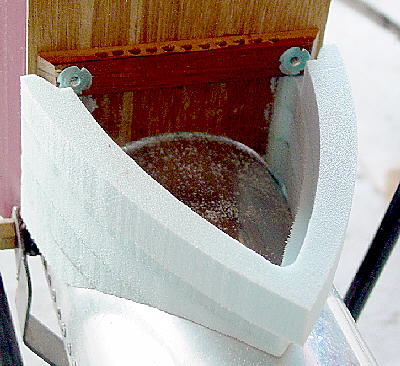 With lower section in place against the fuselage, the first cleat was glued into place. The cleat had been cut to the same width as the foam, and it was centered using the special cut section lying next to it. After the epoxy had set, the assembly was removed from the fuselage tube and the bolt holes drilled through the panel board, and the wood nuts pulled into place.
With lower section in place against the fuselage, the first cleat was glued into place. The cleat had been cut to the same width as the foam, and it was centered using the special cut section lying next to it. After the epoxy had set, the assembly was removed from the fuselage tube and the bolt holes drilled through the panel board, and the wood nuts pulled into place.
|
 Then the assembly had been repositioned on the fuselage, sharp pointed screws were threaded through the nuts from the back side so they would pierce and mark the fabric.
Then the assembly had been repositioned on the fuselage, sharp pointed screws were threaded through the nuts from the back side so they would pierce and mark the fabric.
|
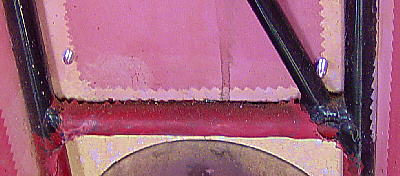 Another view from inside the fuselage looking toward the rear showing the sharp pointed screws.
Another view from inside the fuselage looking toward the rear showing the sharp pointed screws.
|
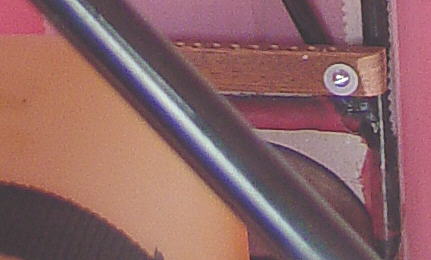 The sharp pointed screws were removed and the inside cleat was installed to clamp the bottom of the fairing. The screws were cut flush with to the nuts. After this the partial assembly was removed. Additional foam pieces were cemented into place until the second cleat level was reached. Then the whole process of drilling and punching holes was repeated two more times.
The sharp pointed screws were removed and the inside cleat was installed to clamp the bottom of the fairing. The screws were cut flush with to the nuts. After this the partial assembly was removed. Additional foam pieces were cemented into place until the second cleat level was reached. Then the whole process of drilling and punching holes was repeated two more times.
|
 After the foam profile had been smoothened, polyester fabric was tacked to the panel board using acrylic glue. The fabric was stretched so that it smoothly conformed to the foam surface. After tacking was completed the excess material was trimmed away, and the remaining fabric was epoxied to the panel board.
After the foam profile had been smoothened, polyester fabric was tacked to the panel board using acrylic glue. The fabric was stretched so that it smoothly conformed to the foam surface. After tacking was completed the excess material was trimmed away, and the remaining fabric was epoxied to the panel board.
|
 The bottom and top ends were stitched to maintain fabric tension at right angles to the previous fabric tacks.
The bottom and top ends were stitched to maintain fabric tension at right angles to the previous fabric tacks.
|
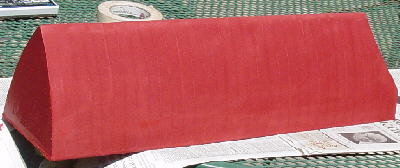 After this the fabric was painted with uncut exterior latex paint. When the paint had set, the stitching was removed from the top and bottom ends, and the excess material was trimmed away. And the top and bottom surfaces were painted.
After this the fabric was painted with uncut exterior latex paint. When the paint had set, the stitching was removed from the top and bottom ends, and the excess material was trimmed away. And the top and bottom surfaces were painted.
|
 All unnecessary wall panelling and foam was cut away to save weight.
All unnecessary wall panelling and foam was cut away to save weight.
|

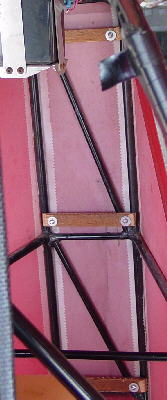 These photos show the fairing in place, the propeller clearance and clamps inside the fuselage.
These photos show the fairing in place, the propeller clearance and clamps inside the fuselage.
Total fairing weight including attachment hardware was 13.2 ounces. The addition of this fairing lets the FireFly maintain 50 mphi cruise at fewer engine rpm. Theortically, the fairing reduces the power required to fly 50 mph by 0.95 hp. |